七年级下册英语教案(第四单元)
- 格式:doc
- 大小:70.00 KB
- 文档页数:8
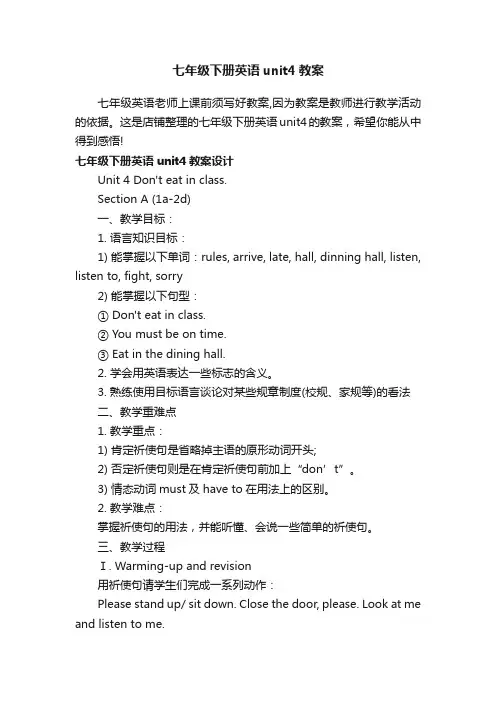
七年级下册英语unit4教案七年级英语老师上课前须写好教案,因为教案是教师进行教学活动的依据。
这是店铺整理的七年级下册英语unit4的教案,希望你能从中得到感悟!七年级下册英语unit4教案设计Unit 4 Don't eat in class.Section A (1a-2d)一、教学目标:1. 语言知识目标:1) 能掌握以下单词:rules, arrive, late, hall, dinning hall, listen, listen to, fight, sorry2) 能掌握以下句型:① Don't eat in class.② You must be on time.③ Eat in the dining hall.2. 学会用英语表达一些标志的含义。
3. 熟练使用目标语言谈论对某些规章制度(校规、家规等)的看法二、教学重难点1. 教学重点:1) 肯定祈使句是省略掉主语的原形动词开头;2) 否定祈使句则是在肯定祈使句前加上“don’t”。
3) 情态动词must及have to在用法上的区别。
2. 教学难点:掌握祈使句的用法,并能听懂、会说一些简单的祈使句。
三、教学过程Ⅰ. Warming-up and revision用祈使句请学生们完成一系列动作:Please stand up/ sit down. Close the door, please. Look at me and listen to me.Don’t open your books. Don’t talk. Let’s begin our class.Ⅱ. 1aT: Now, Look at the picture on your textbook. Each of the students is breaking one of these rules. Please finish 1a.Ⅳ. ListeningNow let’s listen! What rules are these students breaking? Write the numbers after names?Ⅴ. Pair wo rkRead the dialogue in 1cand work in pairs.Ⅵ. Listening1. First, let's read the sentences in 2a together. Now, let's listen to the recording. Check the activities Alan and Cindy talk about.2. Work on 2b: Listen to the recording again. Can Alan and Cindy do these activities? Circle can or can't above.Ⅶ. Pair work1. Suppose you are Alan and your partner is Cindy. Talk about the rules in 2a.2. Let some students come to the front and act out the conversations.Ⅷ. Role-playRead the conversation and find some rules in this school. Ss read the conversations and find the answers to this question.( Don't be late for school. Don't bring music players to school. You always have to wear the school uniform. You have to be quiet in the library. )Homework:1. Remember the new words and expressions.2. 完成下列句型转换试题1)I can play computer games on weekends.(一般疑问句)_________________________________? Yes, ____________.2) He has to wear uniform.(变否定句) He _____ _____ _____ wear uniform.3) I have to wear sneakers for gym class.(一般疑问句)_____ you ____ ____ wear sneakers for gym class? Yes, I ____.4) They have to wash clothes.(提问) ____ do they have ____ ____?5) You can’t go out on school nights.(换一种表达) _______ go out on school nights.6) Don’t talk in class.(同上) No _________.Section A (Grammar Focus-3c)教学重难点1. 教学重点:1) 继续学习使用目标语言谈论对某些规章制度(校规、家规等)的看法2) 通过不同方式的练习方式来学会用英语表达一些标志的含义。
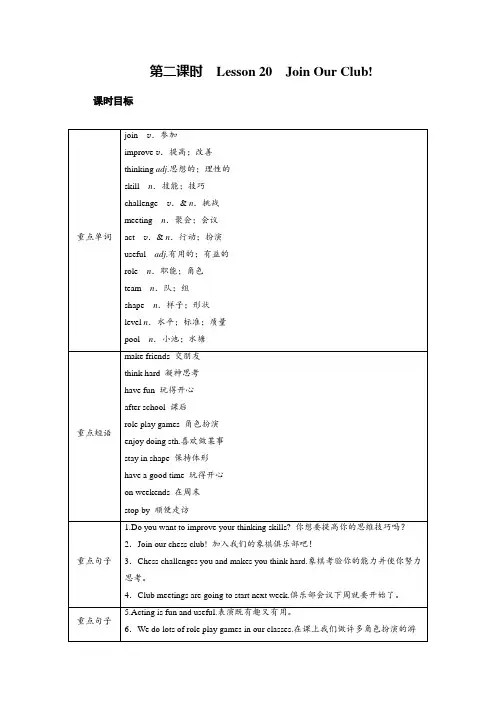
第二课时Lesson 20Join Our Club! 课时目标戏。
7.Join us today or stop by the pool to learn more.今天就加入我们或顺便到泳池边来了解更多情况吧。
教学难点了解不同俱乐部的信息;能用英语描述自己所在的或想加入的俱乐部自主学习一、根据句意及首字母提示写出单词。
1.Are you interested in drawing pictures? Come and join us!2.If you don't know how to improve your thinking skill, we can help you.3.Why are you late for the important meeting?4.I think doing exercises is useful for you.5.We are a good team, though we are at different levels.二、写出下列画线短语的汉语意思。
1.Chess challenges you and makes you think hard.努力思考;凝神思考2.We do lots of role play games in our classes.许多,大量;角色扮演3.Join us today or stop by the pool to learn more.顺便到……来教学过程环节1新课导入教师展示几张与俱乐部有关的图片,然后提问并让学生思考,然后和同桌一起讨论自己参加的俱乐部。
T:What clubs are they, do you know? Now, you can have a discussion with your partners.S1:In Picture 1, it's a camping club.I join the camping club in our school, and you?S2:No, I am not in this club.I am in the chess club now....T:OK! Today we will know more about clubs.设计意图:以图片导入话题,使课堂更具趣味性;通过让学生讨论不同的俱乐部,调动学生参与课堂的积极性,活跃课堂氛围,从而循序渐进地引入本课时的话题,为接下来的学习做好铺垫。
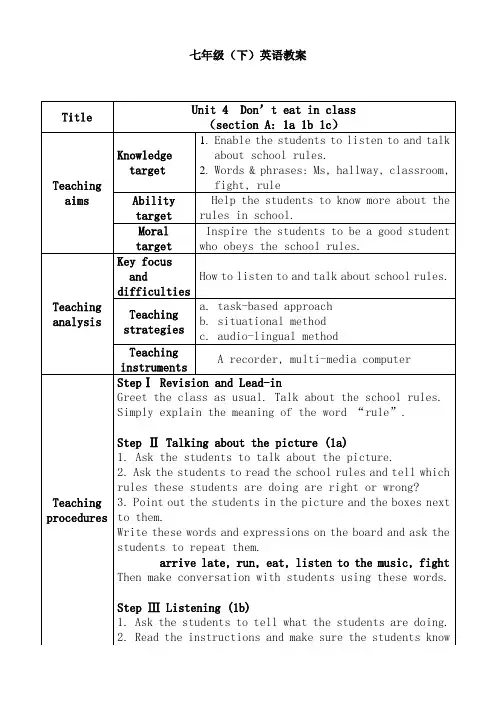

Unit 4 Don’t eat in class.SectionB (1a-2c)知识目标:熟练掌握重点词汇以及重点句型:dirty, kitchen, more, noisy,make one’s bed, be strict with sb. follow the rulesThere are too many rules …I can…; I can’t…;I must…; I have to …; I…技能目标:1.能根据文章特点和活动要求使用寻读策略。
2. 能和朋友谈论校规和家规。
情感目标:能读懂一些英语的规则制度,能用英语表达和制定一些简单的规则,理解没有规矩不成方圆;无论是在学校时还是在家庭中以及以后走上社会都应当遵守规则,按规则办事。
1. 教学重点:1) 学习本课时出现的新词汇及表达方式。
2) 通过进行听力训练,让学生们能听懂本节课时所出现的新的表达方式。
3) 通过进行阅读练习来进一步学习运用本课时的新语言知识。
2. 教学难点1)阅读训练。
2)理解must, have to/ can/can't的用法三、学习过程Ⅰ. Warming- up and revision1. Greet the Ss.2. Check the homework. Let some Ss read their home rules.3.通过图片提问Do you know these signs in a city?What do they mean?4.再通过运用思维导图进行引导How many rules do you know?Ⅱ. Presentation1. Show some pictures on the big screen and let Ss learn the new words and expressions.2. 学生看着1a部分的图片___ go out___ see friends___ do his homework___ practice the guitar___ do the dishes___ watch TV___ help his mom make breakfast___ clean his room进行FREE TALKWhat can you do at home ?What can’t you do ?Can you go out on school nights?Ss: No, we can’t.T: Yes, in China, the students can’t go out on school nights.So please don’t go out on school nights.Ⅲ. Listening1. Tell Ss they'll listen to the recording about Dave's house rules. Listen and put an× for things Dave can't do and a √for things he has to do.2. Play the recording for the Ss to listen and check.3. Play the recording again for the Ss to check the answers.Ⅳ. Listening1. Now let's work on 1c. Now first, let's read the phrases aloud together.help his mom makebreakfastclean his roomWhat are the rules at your home?Can you go out on school nights?Do you have to do your homework first?Lead-inWhen you are unhappy about something, who do you like to talk to ?Task 1.Skimming (速读--默读)1. What’s Molly’s problem?2. Does she have rules in school?3. What does Molly think of the rules?Read 2b quickly and find the main idea. The main idea of the two letters is that___. A: there are many rules for MollyB: Dr. Know wants to help MollyC: Molly asks Dr. Know for some help and Dr. Know gives her some help.Task2. ScanningRead the letters again and complete the timeline (再读信,并且完成时间轴. )Task3.Detailed readingA).Read the first paragraph and fill in the blanks.B)Read the second paragraph and fill the rule made by her dad.C) Dr. Know's advice: We have to _____________.观察与思考求助信的写作格式:1)2)3)2c Read the letters again. Complete the sentences with have to/must, can or can’t.1. Molly _____ play basketball on school days, but she ____ play it on weekends.2. Molly _____ do her homework first when she gets home.3. Molly _____ read a book after dinner before she _____ watch TV.4. At school, Molly ____ be noisy or eat in class.5. Parents and schools make rules to help students. So students ______ follow the rules.Group worke.g.:At school/home/the library, we have to(must) ...We can't...(巩固)Language points1. _________ the guitar 练习吉他practice v.意为“练习”后面可跟名词、代词或动名词。
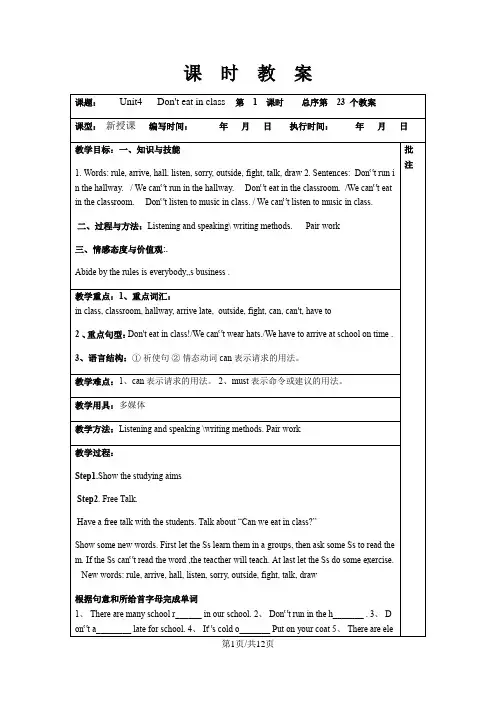
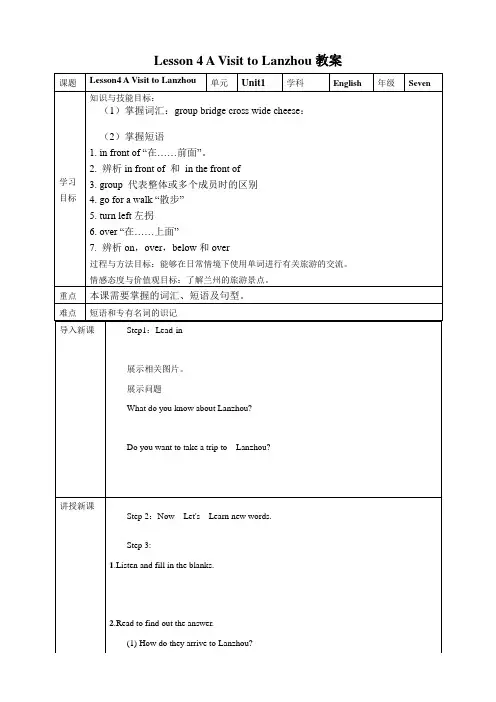
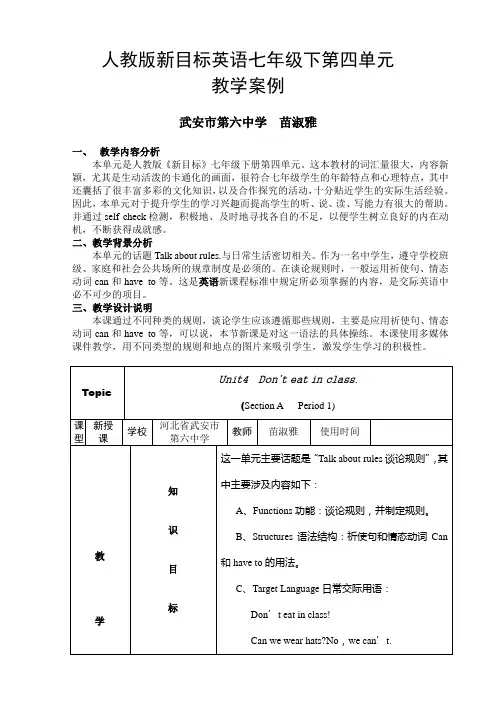
人教版新目标英语七年级下第四单元
教学案例
武安市第六中学苗淑雅
一、教学内容分析
本单元是人教版《新目标》七年级下册第四单元。
这本教材的词汇量很大,内容新颖,尤其是生动活泼的卡通化的画面,很符合七年级学生的年龄特点和心理特点,其中还囊括了很丰富多彩的文化知识,以及合作探究的活动,十分贴近学生的实际生活经验。
因此,本单元对于提升学生的学习兴趣而提高学生的听、说、读、写能力有很大的帮助。
并通过self check检测,积极地、及时地寻找各自的不足,以便学生树立良好的内在动机,不断获得成就感。
二、教学背景分析
本单元的话题Talk about rules.与日常生活密切相关。
作为一名中学生,遵守学校班级、家庭和社会公共场所的规章制度是必须的。
在谈论规则时,一般运用祈使句、情态动词can和have to等。
这是英语新课程标准中规定所必须掌握的内容,是交际英语中必不可少的项目。
三、教学设计说明
本课通过不同种类的规则,谈论学生应该遵循那些规则,主要是应用祈使句、情态动词can和have to等,可以说,本节新课是对这一语法的具体操练。
本课使用多媒体课件教学,用不同类型的规则和地点的图片来吸引学生,激发学生学习的积极性。

主题7B Unit 4(Finding your way) 学习目标1. 掌握Comic strip—Grammar重点词汇、句型;2. 掌握Integrated skills—Self-assessment重点词汇、句型;3. 掌握冠词的用法;4. 掌握表示地点的介词的用法。
教学内容【课堂导学】1、上次课后巩固作业复习;(具体内容无须在此呈现出来)2、互动探索(此部分与上次预习思考相一致,且需要在此部分呈现出来)亲爱的同学们!你们给小明指出路线了吗?First, go straight on and turn right at the park.Next, walk along the Shengping Road and then turn left at the first turning.At last, you will see the barbecue bar at the end of the road.must “必须”,没有人称、数、时态的变化,否定式mustn ’t 表示“禁止” 表示说话人主观上的看法,强调主观上的需要【知识梳理5】Sunshine Zoo is north of Sunshine Middle School. 阳光动物园在阳光中学的北部。
(1) north 名词,意为 ,固定结构为 ,表示 。
指范围之外,且中间有一段距离。
(2) 方位名词与介词in, on, to 连用时的区别含义 用法 in+方位名词在……之内 强调 on+方位名词在……之外 强调 to+方位名词在……之外 强调 【例题精讲】1. The tree is in the north of the school.2. The hill is on the north of the school.3. The cinema is to the north of the school.答案:(1) north 名词,意为“北,北方”,固定结构为be+方位词+of ……,表示“某地在另一地的……方向”。
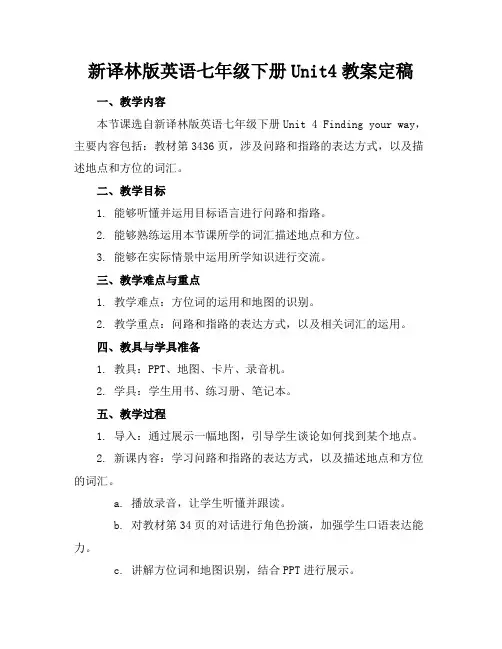
新译林版英语七年级下册Unit4教案定稿一、教学内容本节课选自新译林版英语七年级下册Unit 4 Finding your way,主要内容包括:教材第3436页,涉及问路和指路的表达方式,以及描述地点和方位的词汇。
二、教学目标1. 能够听懂并运用目标语言进行问路和指路。
2. 能够熟练运用本节课所学的词汇描述地点和方位。
3. 能够在实际情景中运用所学知识进行交流。
三、教学难点与重点1. 教学难点:方位词的运用和地图的识别。
2. 教学重点:问路和指路的表达方式,以及相关词汇的运用。
四、教具与学具准备1. 教具:PPT、地图、卡片、录音机。
2. 学具:学生用书、练习册、笔记本。
五、教学过程1. 导入:通过展示一幅地图,引导学生谈论如何找到某个地点。
2. 新课内容:学习问路和指路的表达方式,以及描述地点和方位的词汇。
a. 播放录音,让学生听懂并跟读。
b. 对教材第34页的对话进行角色扮演,加强学生口语表达能力。
c. 讲解方位词和地图识别,结合PPT进行展示。
3. 实践情景:分组活动,让学生根据地图互相问路和指路。
4. 例题讲解:针对教材第35页的练习题进行讲解。
5. 随堂练习:让学生完成教材第36页的练习题,并及时反馈。
六、板书设计1. 问路和指路的表达方式。
2. 描述地点和方位的词汇。
3. 地图的识别和运用。
七、作业设计1. 作业题目:完成练习册对应习题,并进行互相问路和指路的口语练习。
答案:见练习册。
2. 附加作业:绘制一幅地图,标注学校周边的地点,并用英语描述。
八、课后反思及拓展延伸1. 反思:关注学生在课堂上的参与度,以及对方位词和地图识别的掌握情况。
2. 拓展延伸:结合实际情况,让学生在课后尝试用英语向家人描述如何找到某个地点。
鼓励学生多观察生活,提高英语实际运用能力。
重点和难点解析1. 教学难点:方位词的运用和地图的识别。
2. 实践情景:分组活动,让学生根据地图互相问路和指路。
3. 作业设计:附加作业中地图的绘制和英语描述。
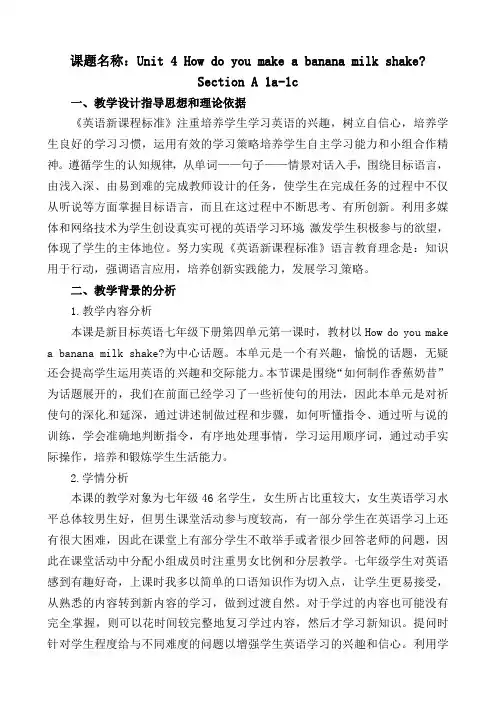
课题名称:Unit 4 How do you make a banana milk shake?Section A 1a-1c一、教学设计指导思想和理论依据《英语新课程标准》注重培养学生学习英语的兴趣,树立自信心,培养学生良好的学习习惯,运用有效的学习策略培养学生自主学习能力和小组合作精神。
遵循学生的认知规律,从单词——句子——情景对话入手,围绕目标语言,由浅入深、由易到难的完成教师设计的任务,使学生在完成任务的过程中不仅从听说等方面掌握目标语言,而且在这过程中不断思考、有所创新。
利用多媒体和网络技术为学生创设真实可视的英语学习环境,激发学生积极参与的欲望,体现了学生的主体地位。
努力实现《英语新课程标准》语言教育理念是:知识用于行动,强调语言应用,培养创新实践能力,发展学习策略。
二、教学背景的分析1.教学内容分析本课是新目标英语七年级下册第四单元第一课时,教材以How do you make a banana milk shake?为中心话题。
本单元是一个有兴趣,愉悦的话题,无疑还会提高学生运用英语的兴趣和交际能力。
本节课是围绕“如何制作香蕉奶昔”为话题展开的,我们在前面已经学习了一些祈使句的用法,因此本单元是对祈使句的深化和延深,通过讲述制做过程和步骤,如何听懂指令、通过听与说的训练,学会准确地判断指令,有序地处理事情,学习运用顺序词,通过动手实际操作,培养和锻炼学生生活能力。
2.学情分析本课的教学对象为七年级46名学生,女生所占比重较大,女生英语学习水平总体较男生好,但男生课堂活动参与度较高,有一部分学生在英语学习上还有很大困难,因此在课堂上有部分学生不敢举手或者很少回答老师的问题,因此在课堂活动中分配小组成员时注重男女比例和分层教学。
七年级学生对英语感到有趣好奇,上课时我多以简单的口语知识作为切入点,让学生更易接受,从熟悉的内容转到新内容的学习,做到过渡自然。
对于学过的内容也可能没有完全掌握,则可以花时间较完整地复习学过内容,然后才学习新知识。
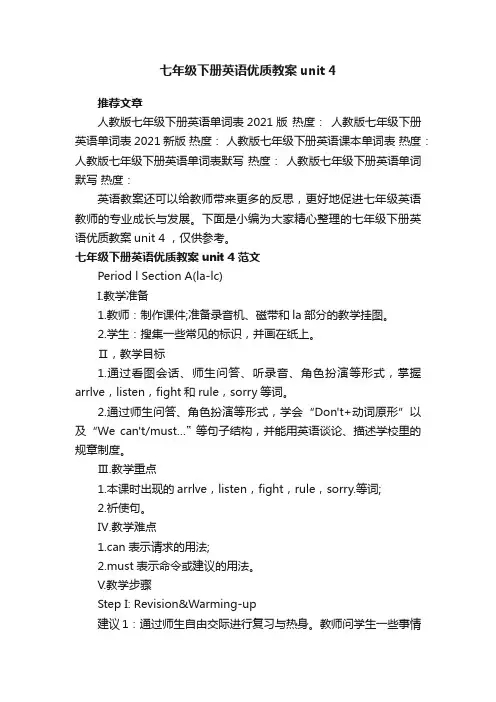
七年级下册英语优质教案unit 4推荐文章人教版七年级下册英语单词表2021版热度:人教版七年级下册英语单词表2021新版热度:人教版七年级下册英语课本单词表热度:人教版七年级下册英语单词表默写热度:人教版七年级下册英语单词默写热度:英语教案还可以给教师带来更多的反思,更好地促进七年级英语教师的专业成长与发展。
下面是小编为大家精心整理的七年级下册英语优质教案unit 4 ,仅供参考。
七年级下册英语优质教案unit 4 范文Period l Section A(la-lc)I.教学准备1.教师:制作课件;准备录音机、磁带和la部分的教学挂图。
2.学生:搜集一些常见的标识,并画在纸上。
Ⅱ,教学目标1.通过看图会话、师生问答、听录音、角色扮演等形式,掌握arrlve,listen,fight和rule,sorry等词。
2.通过师生问答、角色扮演等形式,学会“Don't+动词原形”以及“We can't/must…‟等句子结构,并能用英语谈论、描述学校里的规章制度。
Ⅲ.教学重点1.本课时出现的arrlve,listen,fight,rule,sorry.等词;2.祈使句。
Ⅳ.教学难点1.can表示请求的用法;2.must表示命令或建议的用法。
V.教学步骤Step I: Revision&Warming-up建议1:通过师生自由交际进行复习与热身。
教师问学生一些事情能不能做,为导入新课做准备。
For example:T:Can we play football in the street?Sl:No,we can't.T:Yes. Don't play football in the street. It's dangerous. Can we sleep in class?S2:No,we can't.T:Yes,you are right. Don't sleep in class.建议2:教师呈现一组禁止标识,通过谈论这些标识进行课前热身。
Unit4 SectionA(Grammar Focus3c)参考教案一、教学目标:1. 语言知识目标:词汇学习:掌握新词汇sugar, cheese, popcorn, corn, machine, dig, hole,并复习Section A中的相关词汇。
语法运用:进一步巩固和应用如何用how much和how many来询问事物的数量。
过程描述:能够流畅地使用英语描述制作爆米花的简单过程,并正确使用表示顺序的词汇。
2. 情感态度价值观目标:生活技能培养:通过学习制作爆米花,增强学生的实践操作能力,并了解相关的生活知识。
珍惜劳动成果:让学生认识到制作食物的艰辛,从而懂得珍惜食物,不浪费。
二、教学重难点1. 教学重点:词汇与词组的运用:确保学生能够熟练运用Section A中的词汇和本课的新词汇。
数量提问的掌握:学生能够自如地使用how much和how many来询问食物的数量。
2. 教学难点:过程描述的准确性:能够清晰、准确地描述爆米花的制作过程,包括各个步骤和所需的材料。
名词的可数与不可数:学生能够正确区分可数名词与不可数名词,并会用适当的数量词来描述不可数名三、教学过程Ⅰ. Warming up and revisionGame: How do you make a banana milk shake?Teacher: Let's play a game. We're going to learn how to make a banana milk shake. Who wants to describe the steps first?Student 1: First, you peel the banana.Teacher: Great! Next?Student 2: Next, you put the banana into the blender.Teacher: And then?Student 3: Then, you pour the milk into the blender.Teacher: Finally?Student 4: Finally, you turn on the blender and mix it well.Teacher: Very good! Remember to use "first, next, then, finally" correctly when describing processes.How do you make a Russian soup?Teacher: Now, let's try with a different recipe. How do you make a Russian soup? Student 5: First, you heat the water.Teacher: And?Student 6: Next, you add the vegetables and meat.Teacher: Continue...Student 7: Then, you let it boil for a while.Teacher: And finally?Student 8: Finally, you add salt and pepper to taste, and serve it hot.Teacher: Excellent! Remember, using "first, next, then, finally" helps make instructions clear and easy to follow.Ⅱ. Grammar Focus.1. 学生阅读Grammar Focus中的句子,然后做填空练习。
一、单元学习主题
本课主题属于“人与社会”主题范畴中“社会服务与人际沟通”这一主题群,涉及子主题“良好的人际关系与人际交往”。
二、单元内容分析
本单元分为Section A 与Section B两部分,主要围绕话题“talk about the rules”展开听、说、读、写、看等语言活动。
本单元的听说活动将学生引入谈论规章制度的情景中,让学生体会、学习不同语体中目标语言的表达。
在此基础上,学生通过对语法的学习及操练进一步强化新的语言内容,为学习Section B打下基础。
Section B的场景由“学校”转到“家庭”,在深化训练听、说能力的基础上偏重读、写能力的训练和发展。
单元主题内容结构框架见下图:。
UNIT 4Don ’teat in class.Section A第1课时(1a~1c)自主学习方案1.自学生词,并记着拼读及拼写。
2.预习课本找出要点短语及句子。
(见教案自学导练内容)3.读记后达成自学导练内容。
讲堂导学方案Step 1 情形导入Show the students the picture of fighting.T:Look at the two boys. What are they doing?Ss:(Help Ss) :They are fighting.T : Can we fight?Ss:No,we can't.T : What should we say to the boys?Ss:We should say to them: Don't fight.环节说明:经过师生对话引出新知识—祈使句。
Step 2 达成教材 1a_1c 的任务1.学习 la 中的学校规定,高声朗诵这些规定,而后将这些规定的序号填在相对应的人物旁边。
(3 分钟)2.认真听录音,找出Peter, Amy 和 Mike 违犯了哪些规定,在lb 中的横线上写出la中的数字,师生共同查对答案。
(2 分钟)3.再听一遍录音,同时跟读。
(2 分钟)4.练习 lc 中的对话。
而后编写新对话,小组内进行对话练习,并进行组与组之间的比赛,教师评论。
(5 分钟)5.小结训练。
(3 分钟)把以下祈使句改成否认形式。
(1)Eat in the hall.(2)Talk loudly.Don't eat in the hall. Don't talk loudly.环节说明:听闻联合,第一时间向学生传达语言目标,经过结对对话练习和小结训练,学生能够娴熟掌握祈使句。
Step3 问题研究1.arrive 的用法用arrive,arrive in/at 填空。
(1)When do you arrive in Shanghai every week?(2)When I arrive at Yucai Middle School in Shanghai,it is 7:50.(3)After I arrive here, I begin my class.【注意】 arrive“抵达”,arrive 是一个不及物动词,不可以直接跟表示地址的名词。
2024年新译林版英语七年级下册Unit4精彩教案定稿一、教学内容二、教学目标1. 掌握一般过去时的用法,能够熟练运用动词过去式描述过去发生的事情。
2. 学会使用与过去时相关的词汇和表达,提高英语口语表达能力。
3. 能够理解并运用课文中的重点句型和语法结构,进行简单的英语写作。
三、教学难点与重点1. 教学难点:动词过去式的变化规则,一般过去时的运用。
2. 教学重点:掌握与过去时相关的词汇和表达,学会运用一般过去时描述过去的事情。
四、教具与学具准备1. 教具:多媒体设备、黑板、粉笔、卡片等。
2. 学具:课本、练习本、彩色笔等。
五、教学过程1. 引入:通过展示一组过去发生的图片,让学生用英语描述图片中的场景,引出一般过去时。
2. 呈现:讲解一般过去时的用法,展示动词过去式的变化规则,让学生跟读并模仿。
3. 实践:进行小组活动,用一般过去时描述过去的事情,互相交流。
4. 例题讲解:分析课文中的一般过去时的句子,解释语法结构和用法。
5. 随堂练习:让学生完成Workbook中的练习题,巩固所学知识。
6. 口语练习:设置情景,让学生用英语进行角色扮演,练习一般过去时的口语表达。
六、板书设计1. 一般过去时的用法2. 动词过去式的变化规则3. 与过去时相关的词汇和表达4. 课文重点句型七、作业设计1. 作业题目:(1)根据所给图片,用一般过去时描述图片中的场景。
(2)用一般过去时写一篇小作文,描述你昨天下午的活动。
答案:(1)例:Yesterday afternoon, I played football with my friends in the park. We had a great time.(2)略。
八、课后反思及拓展延伸1. 课后反思:关注学生在课堂上的表现,了解他们对一般过去时的掌握程度,针对存在的问题进行反思,调整教学方法。
2. 拓展延伸:鼓励学生在课后多进行英语口语练习,观看英语动画片或电影,提高英语听说能力。
第4课时Section B(2a-Self Check) 【学习目标】【课堂导学】Step 1 情景导入Teacher:When you are unhappy about something,who do you like to talk to,your parents,your teachers or your friends?Can you tell me?Students:…Teacher:Molly is a student like us. She is very upset. Do you know why she is unhappy,and who she likes to talk to?环节说明:通过情景导入既完成了2a的学习又引出了Molly的烦恼,引起学生的好奇心,激发了他们的学习欲望。
Step 2 完成教材2a~2c的任务1.小组内讨论2a的问题。
2.快速阅读2b信件了解信件内容,圈出Molly 的家规。
(2分钟)3.再次认真阅读信件,回答下列问题。
(3分钟)(1)Are there many rules at Molly's home?(2)How does Molly go to school?(3)Does Molly never play basketball?4.第三遍阅读短文完成2c的选词填空。
(3分钟)5.小结训练。
(4分钟)单项选择。
(1)Please don't make so much__A__.It's too______.A.noise;noisy B.noisy;noisy C.noise;noise D.noisy;noise(2)Mr. Zhang is our English teacher,and he is very strict__C____us and__________his work.A.in;in B.with;with C.with;in D.in;with(3)__B__he________I can go there by bike because there is only one bike.A.Between;and B.Either;or C.Neither;or D.Either;and环节说明:这一环节的学习不仅巩固了本单元的语法,而且还锻炼了学生阅读能力和概括能力。